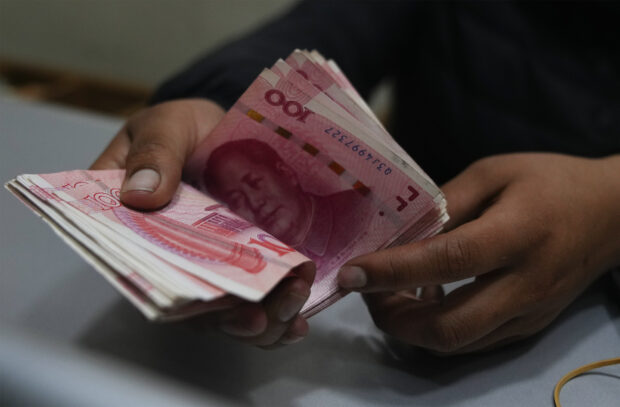Bolivia is latest South American nation to use China’s yuan for trade

A money exchange shop worker counts Chinese yuan banknotes in La Paz, Bolivia, Wednesday, July 26, 2023. Bolivia’s state-run bank, Banco Union, has started to carry out transactions using China’s currency, the yuan. (AP Photo/Juan Karita)
LA PAZ, Bolivia — Bolivia is now using the yuan to pay for imports and exports, becoming the latest country in South America to regularly use the Chinese currency in a small but growing challenge to the hegemony of the U.S. dollar for international financial transactions in the region.
Between May and July of this year, Bolivia conducted financial operations amounting to 278 million Chinese yuan ($38.7 million), which accounts for 10 percent of its foreign trade during that period, Economy Minister Marcelo Montenegro said on Thursday.
“We’re already using the yuan. It’s a reality and a good start,” Montenegro said during a news conference. “Banana, zinc, and wood manufacturing exporters are conducting transactions in yuan, as well as importers of vehicles and capital goods.” These electronic transactions are carried out through the state-owned Banco Unión.
“The amount being used in yuan is still relatively small, but it will increase over time,” Montenegro said.
With these transactions, Bolivia joins other countries in South America, most notably Brazil and Argentina, which are using the yuan. The three countries are ruled by leftist or left-leaning governments.
In Latin America and the Caribbean, the use of the yuan is growing especially “in those countries that are looking to establish stronger ties with China, that view themselves as in some way politically aligned on this particular objective on decreasing their overall reliance on the dollar and on the U.S. in general,” said Margaret Myers, director of the Asia & Latin America Program at the Washington-based Inter-American Dialogue.
The use of the yuan comes at a time when China’s footprint in the region is increasing with rising trade and investment.
“There is a lot of anxiety in Washington about threats to the special role of the dollar in regions like Latin America,” Benjamin Gedan, director of the Latin America Program at the Washington-based Wilson Center, said. “China’s new role as a lender of last resort in Argentina, and the use of the yuan for international trade by Bolivia, are a sign of the times.”
Earlier this year, Argentina’s government unveiled a plan to use the yuan to pay for imports from China as a way to preserve its dwindling foreign reserves and it has raised the possibility of paying off debts with the International Monetary Fund using the Chinese currency. In Brazil, the yuan surpassed the euro as the second most important currency in its foreign reserves at the end of 2022, when 5.37 percent of the central bank’s holdings were in the Chinese currency, compared to 4.74 percent for the euro.
In Bolivia, the yuan started to be used after months of severe dollar shortages that have been impacting the country’s economy since February.
Some analysts and members of the opposition have questioned the move to use the yuan.
“It is not a long-term solution, and it seems more like an attempt to cover up economic problems,” said José Gabriel Espinoza, an economics professor at Bolivia’s Catholic University.
The manager of the Chamber of Exporters of Bolivia, Marcelo Olguín, dismissed the criticism, characterizing the use of the yuan as merely “an alternative to operate.”
Beyond political considerations, looking for alternatives to the U.S. dollar that has become more expensive amid rising interest rates also makes economic sense, said Rebecca Ray, senior academic researcher at the Boston University Global Development Policy Center.
“They’re all facing the same global macroeconomic conditions, and the most important part of that is the US dollar is really expensive and hard to get a hold of. So there’s basically a global dollar shortage among current central banks,” Ray said. “Central banks everywhere are looking for alternatives.”
Bolivia’s President Luis Arce said earlier this month the Andean country was looking for alternatives amid a “dollar liquidity crisis.”
During a visit to China in April, Brazilian President Luis Inácio Lula da Silva questioned the omnipresence of the U.S. dollar in foreign trade.
“Who was it that decided that the dollar was the currency after the disappearance of the gold standard?” he said.
Beijing is welcoming this new dynamic after years of a concerted effort to push for the yuan to be used more widely on the international stage.
“China clearly wants to challenge the global dominance of the dollar, both for practical and symbolic purposes,” Gedan said.
Now that is starting to be more appealing to more countries.
“China has been wanting to internationalize (its currency) for many years. What is new is that other countries are receptive to the idea because the current situation isn’t sustainable,” Ray said.
Experts agree though that any large-scale shift to the yuan is unlikely in the near future.
“I think there’s a sort of natural limit that most countries will hit,” Myers said. “So many transactions still need to be done using the dollar.”
The “primary limitation here is the fact that the Chinese financial system is still relatively closed,” Myers added.
Gedan added that at least “for now, there is generally more faith in the Fed than in China’s central bankers.”
Read Next
Subscribe to INQUIRER PLUS to get access to The Philippine Daily Inquirer & other 70+ titles, share up to 5 gadgets, listen to the news, download as early as 4am & share articles on social media. Call 896 6000.
For all the latest Business News Click Here
For the latest news and updates, follow us on Google News.



